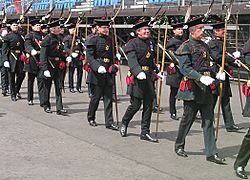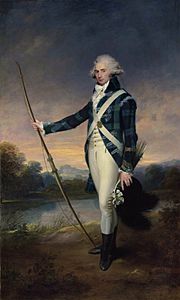Royal Company of Archers facts for kids
Quick facts for kids The Royal Company of Archers,The King's Bodyguard for Scotland |
|
|---|---|
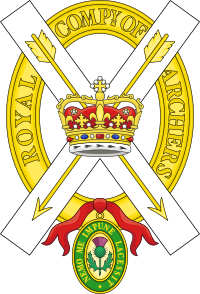
Badge of the Royal Company of Archers
|
|
| Active | 1676–present |
| Country | Scotland |
| Type | Private archery club |
| Role | Royal bodyguard |
| Size | 530 |
| Part of | Sovereign's Bodyguard |
| Garrison/HQ | Edinburgh |
| Motto(s) | Dal gloria vires Nemo me impune lacessit Dulce pro patria periculum |
| Colours | two standards |
| March | Archer's March |
| Commanders | |
| Captain-General | The Duke of Buccleuch and Queensberry |
| Insignia | |
| Hackle | Eagle Feathers Number dependent on rank |
The Royal Company of Archers, The King's Bodyguard for Scotland is a special group that acts as the King's personal bodyguard in Scotland. They have been doing this important job since 1822. That's when King George IV visited Scotland, and the company protected him.
Today, they are often called the King's Bodyguard for Scotland or simply The Royal Company. You can find them in Edinburgh, the capital city of Scotland. This group has a long history of celebrating archery skills and fun. Since a monarch first created them, they have had special awards, powerful supporters, and important ceremonial duties. They also have a charity that helps people in Scotland with their health and well-being.
Contents
How the Royal Company Started
In the 1600s and 1700s in Scotland, there were events called "wapinschaws." These were like weapon shows, held at least twice a year. Men had to attend these shows in their local areas. Local leaders and royal officials would watch these groups of men. They would divide them into companies and choose captains. Everyone had to come ready with military gear that matched their social standing.
A group that loved and practiced archery formed in 1676. This was a private club at first. They used the old "wapinschaw" laws to create a military group. This group could be called together when needed, but it looked like a sports club. The Scottish government supported them and even gave them a prize for their archery contests. Many important nobles and gentlemen were part of this early group.
In 1713, Queen Anne gave the society a special document called a Royal Charter. This made them an official "Royal Company." This charter allowed them to:
- Bring back old laws that supported archery.
- Welcome new members.
- Choose their own leaders.
- Meet in a military style for weapon shows without being stopped by local officials.
In return for these rights, the Royal Company had to give the monarch three special barbed arrows if asked. The first big weapon show under this new charter happened on June 14, 1714. About 50 archers took part.
Fun Traditions and Prizes
The Royal Company has many traditions, mostly linked to their archery competitions. They used to compete for thirteen different prizes each year, and many of these are still used today.
The Musselburgh Arrow
One old tradition is shooting for the silver Musselburgh Arrow. This small arrow was first given by the town of Musselburgh in 1603. The winner gets to keep the arrow for a year. When they pass it on, they add a small medal to it. This medal has their own personal motto engraved on it. By 1816, the company had 103 such medals!
The Edinburgh Arrow
The City of Edinburgh gave The Edinburgh Arrow in 1709. The medals added to this arrow are made of gold. This competition happens every year at Bruntsfield Links nearby. The rules say it should be shot for on the second Monday of June each year. In 2009, they celebrated the 300th anniversary of this competition.
The Silver Punch Bowl and Ladle
Another prize is The Silver Punch Bowl and Ladle, given to the company in 1720. Winners also add medals to this bowl. The bowl itself cost £20 to make. It has the company's seal and a special message carved into it.
The Pagodas Medal
This prize is a medal given in 1793. It was made from 50 "pagodas," which were coins. These coins were part of the money paid by Tipu Sultan after a treaty in 1792.
Silver Vase and Gold Medal
General John Hope, 4th Earl of Hopetoun gave a prize to remember King George IV's visit in 1822. This "Commemoration Prize" is still competed for every year on the King's or Queen's birthday.
The Royal Prize of 20 Guineas
Since 1677, there has been a competition for The Royal Prize. The winner receives £20. The catch is, they must use that money to buy a silver item for the Company. This item must have archery symbols on it.
The Silver Bugles
Two Silver Bugles are also prizes. One was given in 1830 by Sir Henry Jardine. The second was given later by the Sovereign's Bodyguard.
St. Andrew's Prize
In the 1840s, Sir George Steuart Mackenzie gave the "St. Andrew's Prize." It is a St. Andrew's Cross.
Prize of the Goose
This prize has been competed for since 1703. In the past, it involved a live goose. Now, it's done by shooting at a small glass globe. This globe is about an inch wide and placed in the center of a target. The first person whose arrow breaks the globe becomes the "Captain of the Goose" for the year. They also win a gold medal.
The Gold Medal
This is a very popular prize. The competition for it happens three times a year, lasting three days each time. The scoring is done with points, like in regular archery contests.

What the Royal Company Does
Today, the company's main jobs are ceremonial. Since 1822, they have been the King's 'Body Guard in Scotland'. They attend the monarch at various events during the yearly Royal Visit to Scotland. This happens when the King or Queen is within five miles of Edinburgh.
Their duties include:
- Attending special ceremonies for the Order of the Thistle at St Giles Cathedral.
- Being present at the Royal Garden Party.
- Taking part in the Ceremony of the Keys at the Palace of Holyroodhouse.
- Presenting new flags (called colours) to Scottish regiments.
At Holyroodhouse, they form a guard of honour in the corridors. The company arrives at Holyroodhouse at noon. They march in, led by their pipes and drums band. They carry their unstrung bows in their right hands.
The company has its own special song, the "Archer's March." Allan Ramsay composed it. It is played on important occasions.
Let hills and dales rebound it,
Let hills and dales rebound it
In praise of Archery.
Used as a Game it pleases,
The mind to joy it raises,
And throws off all diseases
Of lazy luxury.
|
Now, now our care beguiling, |
Tis now the archers royal, |
Sound, sound the music, sound it, |
How the Company is Organized
The Royal Company of Archers has its main building, called Archers' Hall, in Edinburgh. Construction started in 1776 and finished in 1777. The Hall was made bigger in 1900 and recently updated. It has a large hall, two smaller rooms, a kitchen, and other spaces. The land behind the Hall used to be a bowling green. Today, the Hall is used for dinners and meetings for the Royal Company.
A President and six counselors manage the company's business. They are chosen every year by all the members. The Adjutant, an officer, is the only person on the Council automatically. The Council decides who can join the company and appoints its officers.
The group is split into officers and regular Archers. The officers, from highest to lowest rank, are: one Captain-General, four Captains, four Lieutenants, four Ensigns, and twelve Brigadiers.
The company started with about 50 members. By the late 1700s, it had around 1,000 members. By the 1930s, it had more than 500. The Captain-General holds a special role called the Gold Stick for Scotland.
Every officer in The Royal Company has the rank of a general. The regular Archers rank as colonels at Court. To become a member, you must be Scottish or have strong Scottish connections. Members are chosen by election. Currently, there are about 530 members, with around 400 active. Members pay a yearly fee and also pay for their uniforms, equipment, and travel.
Company Flags (Standards)
The Royal Company has two special flags, called standards.
- The first flag shows Mars (the Roman god of war) and Cupid (the god of love) surrounded by thistles. Its motto is: In peace and war. On the other side, it shows a yew tree with two archers. Its motto is: Dal gloria vires (Glory Gives Strength).
- The second flag shows a red lion rampant on a gold background. This is the Royal Arms of Scotland. It has a thistle and crown on top. Its motto is: Nemo me impune lacessit (no one provokes me with impunity). On the other side, it shows Saint Andrew on a cross. It has a crown on top. Its motto is: Dulce pro patria periculum (danger is sweet for one's country).
After a third-place winner was added to a competition in 1720, three arrows were added to one of the standards.
Uniforms
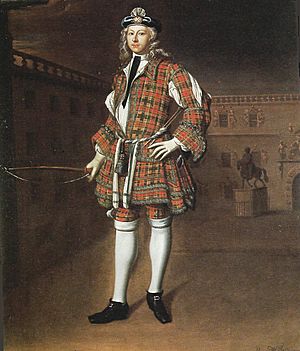
The Royal Company of Archers was one of the first groups serving the British Crown to use tartan as part of their uniform.
Their first uniform was a "shooting" outfit. It had a tartan, lined with white, and decorated with green and white ribbons. It also included a white sash, a blue hat (bonnet) with a St. Andrew's cross, a tartan coat, knee-breeches, and a white vest. Tartan was popular then as a way to show Scottish pride. Many members were known to support the Jacobites, who wanted to restore the Stuart kings.
From 1713 to 1746, they wore a red tartan for their shooting uniform. This included a tunic, coat, and short trousers. After the Battle of Culloden, a law banned wearing tartan. But this law was removed in 1783, and tartans were worn again. However, in 1789, they changed from the red tartan to the Black Watch tartan.
Later in the 1800s, when Queen Victoria visited Glasgow, her Scottish Body Guard wore dark green tunics. These tunics had black trim and a thin crimson stripe. They also wore dark green trousers with black and crimson stripes. They had a bow case worn like a sash, decorated with two arrows forming a St. Andrew's cross. They also wore a black leather belt with a gold buckle, a short sword, and a Highland hat (bonnet) with a thistle and eagle feathers.
Until World War II, their uniform was a formal court dress. It was green with gold embroidery and a special hat with dark cock's feathers. Officers had gold embroidery, and their rank was shown by the number of feathers in their hat. The shooting uniform today is a dark-green tunic with crimson trim, dark-green trousers, a bow-case sash, a black waistbelt with a sword, a Highland cap with a thistle, and eagle feathers. They also carry a hunting knife with this uniform.
Leaders of the Company (Captains-General)
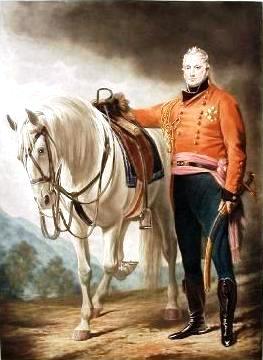
The Captain-General is the highest leader of the Royal Company of Archers. Here is a list of some of the people who have held this important position:
- John Murray, 1st Marquess of Atholl c.1676–1703
- George Mackenzie, 1st Earl of Cromartie 1703–1714
- David Wemyss, 4th Earl of Wemyss 1715–1720
- vacant
- James Hamilton, 5th Duke of Hamilton 1724–1743
- James Wemyss, 5th Earl of Wemyss 1743–1756
- Charles Douglas, 3rd Duke of Queensberry 1756–1778
- Henry Scott, 3rd Duke of Buccleuch 1778–1812
- Charles Montagu-Scott, 4th Duke of Buccleuch 1812–1819
- John Hope, 4th Earl of Hopetoun 1819–1823
- James Graham, 3rd Duke of Montrose 1824–1830
- George Ramsay, 9th Earl of Dalhousie 1830–1838
- Walter Montagu-Douglas-Scott, 5th Duke of Buccleuch 1838–1884
- William Montagu-Douglas-Scott, 6th Duke of Buccleuch 1884–1914
- John Montagu-Douglas-Scott, 7th Duke of Buccleuch 1914–1935
- Sidney Buller-Fullerton-Elphinstone, 16th Lord Elphinstone 1935–1953
- John Dalrymple, 12th Earl of Stair 1953–1961
- Walter Montagu-Douglas-Scott, 8th Duke of Buccleuch 1961–1973
- John Dalrymple, 13th Earl of Stair 1973–1988
- Ronald Colville, 2nd Baron Clydesmuir 1988–1996
- Sir Hew Fleetwood Hamilton-Dalrymple, 10th Baronet 1996–2004
- David Ogilvy, 13th Earl of Airlie 2004–2006
- James Graham, 8th Duke of Montrose 2006–2014
- Richard Walter John Montagu Douglas Scott, 10th Duke of Buccleuch, 12th Duke of Queensberry 2014–present
Famous Members
Over the years, many interesting people have been members of the Royal Company. These include soldiers, scientists, lawyers, and politicians.
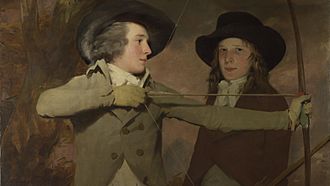
- Robert Ferguson of Raith (1770–1840) and his brother Lt-Gen. Sir Ronald Craufurd Ferguson (1773–1841) – They are the people in the famous painting, "The Archers."
- Sir Walter Scott (1771–1832) – A very famous Scottish writer.
- Sir Henry Raeburn (1756–1823) – A well-known Scottish painter.
- Robert Burns (1759–1796) – Scotland's national poet.
- John Rattray (1707–1771) – A surgeon and golfer.
- Sir Tony Keswick (1903–1990) – A successful businessman.
- Sir Malcolm Rifkind (1946-) – A former Secretary of State for Scotland.
- Alister Jack (1963-) – The current Secretary of State for Scotland.
- Ben Wallace (1970-) – A former Secretary of State for Defence.
Why the Company is Important
The Royal Company is a part of the King's official household in Scotland. Their building, Archers' Hall, is a special historic building. It is recognized for its regional importance and its unique style.
See also
- Woodmen of Arden
- High Constables and Guard of Honour of the Palace of Holyroodhouse


